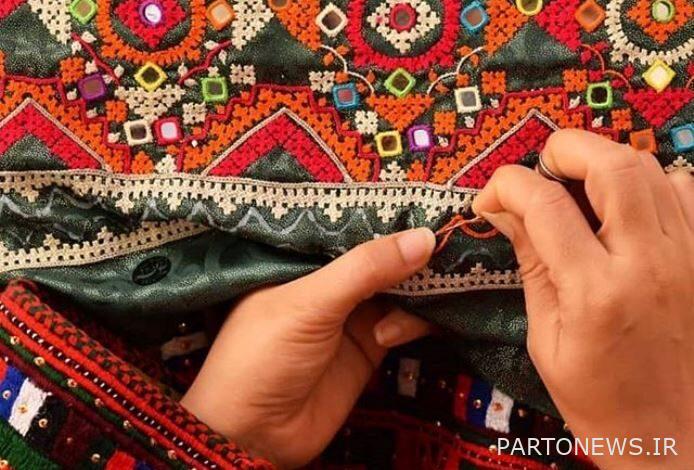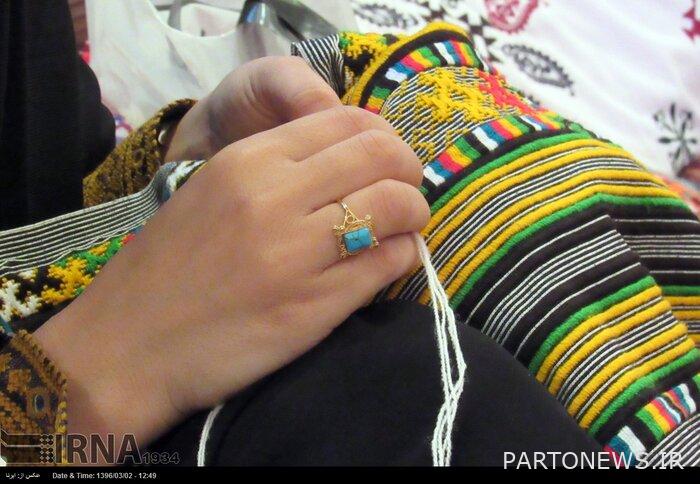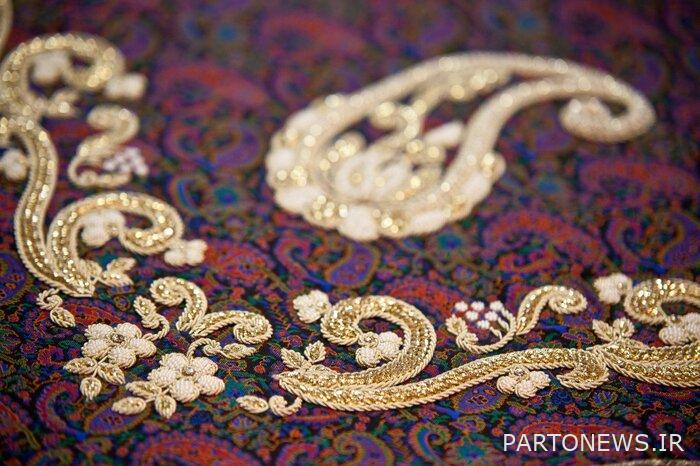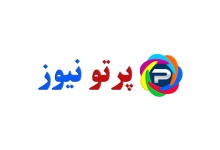Lady Qazvini has created employment for 200 people with thread and needle

According to IRNA, today, handicrafts and traditional arts, regardless of their beauty and applications, are a good platform for job creation and entrepreneurship, and many men and women, especially in local and urban communities, make a living from the production and sale of handicraft products. Many economic and social actors have invested in this sector.
According to the cultural heritage officials of Qazvin province, in the first half of this year, about 2 million and 250 thousand dollars of handicrafts were exported from the province to neighboring countries and the Persian Gulf and Europe.
Handicrafts are part of the arts and crafts of nations that have artistic values and special capacities in addition to consumer aspects due to their cultural and artistic values and taste and thought in production.
In the current situation where unemployment is one of the main problems of society, starting and developing home businesses is a low-cost and high-yield solution to deal with the problem that home-based businesses in addition to generating income for the community also play a role in increasing GDP.
Women, as half of the country’s population, can play an important role in economic prosperity, especially if they are employed at home, which is an opportunity to earn a living by taking advantage of a safe home environment.
IRNA correspondent in Qazvin province coincides with Women’s Week with Raheleh Kargarian Marvasti, a woman entrepreneur and artist from Qazvin Who has managed to create jobs for 200 Qazvini women in the field of needlework and handicrafts, has sat down for a conversation.
Marousti workers, stating that needlework has a great variety in terms of designs, colors and patterns, added: “Traditional needlework is one of the traditional needlework and the whole needlework of the country, which is about 1,500 types, also includes different regions.”
IRNA. Define needlework? How did you get into this art?
Needlework is one of the unique embroideries in Iran and is an art with delicate sewing and variety of colors that express the taste, taste, tradition and art of Iranian women.
Needlework is one of the arts that can be used to turn a simple fabric into a handmade and spectacular work of art, and this art can be introduced as the flagship of handicrafts.
This art has a long history and has not lost its importance to this day. In the art of needlework, the artist draws his design on the fabric using a simple and gentle color.
I have been working in various fields of handicrafts for almost 20 years and I have been working in the training and production of embroidery for almost 10 years. Needlework of Qazvin artists, which was held during Nowruz, I became interested in this art and I was involved in training 24 hours a day, and sometimes I even traveled to other provinces for training, and today I work professionally in the field of needlework. I have training and production work.
IRNA. How do you prepare the materials needed for your work?
Needlework has about 1,500 types of sewing, and if we want to provide equipment for each of these types of sewing, it has its difficulties, but some of the required equipment is provided from the market, which has a good price and material.
Also, for some stitches, the necessary tools must be provided from other provinces, for example, kohl embroidery from Yazd province or other stitches from Sistan and Baluchestan, Kurdistan and Khorasan provinces until the product is of good quality.
Handicraft artists often face a lot of difficulties in preparing raw materials and tools, and for convenience, these tools are sometimes provided from Tehran.
IRNA. How many people work in your workshop?
In the past, when I was working with a personal brand, people worked with me on a seasonal basis, and after examining the issues and problems, I thought of forming a cooperative. It has been done by artists. Fortunately, with the registration of this cooperative company, a lot of members have been recruited and we have held several exhibitions in the same short period of time and we have had good sales. We hope that through cooperatives, we will be able to procure raw materials at reasonable prices and also market our products.
IRNA. What is the most important problem for handicraft artists?
One of the main challenges for handicraft artists is the sale and supply of their products, which by creating a permanent market and exhibition, the problem of selling artists’ products is largely solved.
Fortunately, Qazvin province, with its numerous artists, has a good capacity in this field, which, if supported, can achieve good results, and the creation of seasonal exhibitions does not meet the needs of these people.
Also, lack of space to supply raw materials and supplies and packaging of manufactured goods, lack of a specific brand, import of handicrafts copied from neighboring countries at cheaper prices, poor planning and culture are important challenges for handicraft artists in the province and the country. Is.

IRNA. What is the most important factor for economic prosperity in the corona art market?
Despite the outbreak of the corona and the closure of many exhibitions and tourist centers, we continued to produce our art products, and we believe that anyone who wants to consider needlework as a source of income must be up-to-date and according to the time and customs of their city. Pay art discipline.
Today in Qazvin province, needlework such as head embroidery, ribbon embroidery, forty pieces (Qazvin needlework) and embroidery are more popular; Also, since we are in contact with other provinces through the sales site, we have seen this welcome in other provinces as well, and cyberspace has created a suitable platform for selling our products.
Also during Corona, we put the production of embroidered masks with attractive designs on the agenda, and during this time we produced masks that had a special effect.
The Cultural Heritage, Handicrafts and Tourism Organization of Qazvin Province also held a competition entitled “Sewing Masks Decorated with Traditional Patterns and Designs Using Creativity and Innovation of Artists” and we won first and second place in the production of traditional masks and needle masks. We designed different embroideries with bags and clothes, which were welcomed by the citizens.
Currently, handicraft fairs have been activated in the province, and people who have been vaccinated twice with Corona can participate in this fair.
Exhibitions are the best place for advertising and marketing for handicrafts; It also makes us familiar with the tastes of people in all parts of the country and act according to their tastes.
IRNA. When it comes to needlework, most minds go to provinces like Sistan and Baluchestan. Does needlework belong to a particular province?
Needlework is one of the native and well-known arts in Iran and among the types of needlework, Baluchi needlework is the most famous, but Iranian needlework is not limited to Baluchi needlework and other cities such as Isfahan, Kurdistan, Semnan, Bandar Abbas and artists. Turkmen and other provinces follow it and even Qazvin province has its own style and damp embroidery is one of the unique styles of needlework in Qazvin province that has long been used for bride dowry and most Qazvin families use this They used art.
Embroidery is a combination of colored beads that are sewn in a row and fills a space completely, and embroidery is a beauty that is disappearing and we try to revive this type of style and embroider the needle. Return to Qazvin families, examples of these needlework can be seen in the museum of Qazvin province.
Needlework, which has been registered in the name of Qazvin province in recent years, is one of the fields of kohl embroidery and a combination of kohlrabi and sequins.
The embroidery we do is an old embroidery that is embroidered, this kind of forgetting style that was used in the past for court dresses.
At present, this type of needlework has been updated and a number of stitches have been added to it, which fortunately has been welcomed by many and is being registered nationally. Its initial standardization is underway and its trainings are being carried out in the name of Qazvin, and we will soon have the unveiling of this type of style at the Tehran International Exhibition.

IRNA. Are you satisfied with the income of needlework and do you have a market to supply your products?
Yes. Anyone who wants to consider the field of needlework as a source of income must be up-to-date and practice this field of art according to the time and customs of their city.
Needlework has many models and stitches, but some needlework is being forgotten. If we want to have a good income through needlework, we need to update the needlework, which will have a good market.
IRNA. Have imported products also had a negative effect on your field of work?
Unfortunately, some needlework that is specific to Iran is being produced in neighboring countries, so we ask the authorities to stop importing needlework that is specific to Iran from neighboring countries and to export the art of Iranian artists.
IRNA. Many university graduates are currently unemployed. What advice do you have for these people?
The field of handicrafts is very diverse and interested people can go to schools approved by cultural heritage and handicrafts and learn these arts and produce products in addition to their administrative and educational work. With this action, while creating jobs, Iranian handicrafts will be known everywhere and many handicrafts will be revived and flourished.
last word:
I am happy that I have been able to preserve a traditional art to the best of my ability and I would like to pass on this ancient art to the next generations by introducing and teaching it.
.
